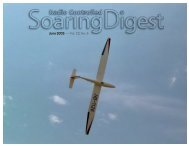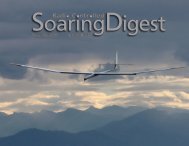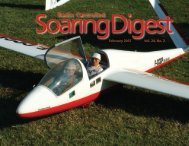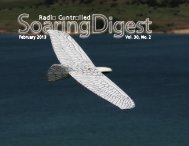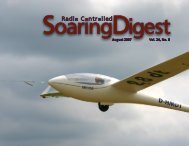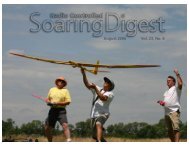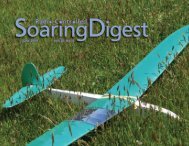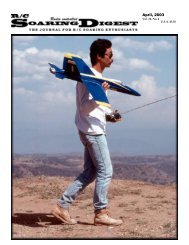December 2005 — Vol. 22, No. 12 - RC Soaring - RCSoaring.com
December 2005 — Vol. 22, No. 12 - RC Soaring - RCSoaring.com
December 2005 — Vol. 22, No. 12 - RC Soaring - RCSoaring.com
Create successful ePaper yourself
Turn your PDF publications into a flip-book with our unique Google optimized e-Paper software.
GWS makes slope versions of<br />
many of their models, but I get<br />
the impression they don’t sell<br />
many kits that way. I have<br />
never seen any on the shelf.<br />
This would be a great chance to<br />
experiment. On one occasion I<br />
had flown the powered version<br />
in light slope lift, cheating<br />
with the motor as necessary.<br />
Maybe without the drag of a<br />
prop and landing gear it would<br />
be a decent sloper.<br />
It is amazing what you can do<br />
with epoxy, rubber bands and<br />
clothes pins. Two nights later,<br />
the Splatfire was back<br />
together. I found the old four<br />
cell 250 mah nicads from the<br />
Zagi THL, and popped them<br />
into the nose where the electric<br />
motor had been. I clipped off<br />
the landing gear, both main<br />
and tail wheel. I glued the<br />
motor mount back together<br />
and used it to hold the prop<br />
shaft in place so I had a place to<br />
mount the spinner.<br />
As an electric prop plane the<br />
Splatfire had been in dire need<br />
of nose weight, so I had<br />
gooped some fishing weights<br />
inside the rubber spinner and<br />
epoxied a big flat iron washer<br />
to the front of the fuse right<br />
behind the spinner. I left those<br />
items in place. Even so, as a<br />
sloper, with the small 4 cell<br />
battery, no motor and no<br />
landing gear the Splatfire was<br />
suddenly 4.8 ounces lighter.<br />
The CG was pretty near the<br />
same. It was kind of ugly, but<br />
people expect that of slopers in<br />
general and my planes in<br />
particular.<br />
I experimented with mixing a<br />
batch of 5 minute epoxy with<br />
some balsa filler <strong>com</strong>pound<br />
and a shot of green acrylic<br />
paint, to make some epoxy<br />
spackle to fill up the cracks in<br />
the fuselage. It worked pretty<br />
well.<br />
The postal scale at work<br />
showed that the Splatfire now<br />
weighed <strong>12</strong> ounces, pretty<br />
much what the GWS manual<br />
said a Spitfire sloper should<br />
weigh. Wing loading was<br />
down from about 10 ounces<br />
per square foot to 7.8 ounces<br />
per square foot. The Splatfire<br />
used to feel like a doorstop.<br />
<strong>No</strong>w it felt like a sailplane.<br />
We’d see.<br />
My first chance came<br />
mid-week, while I was<br />
recovering from April 15 th . I<br />
played hooky for a couple of<br />
hours and drove over to<br />
Newark to take advantage of a<br />
warm day and 20 m.p.h. winds<br />
from the southwest. The<br />
Splatfire flew pretty well from<br />
the very start. I had felt that I<br />
had the CG a little further back<br />
than it had been as a power<br />
plane, and indeed the elevator<br />
was very sensitive. I dialed it<br />
back to 40% on dual rates.<br />
The Splatfire is fairly fast. I had<br />
a Cavasos Boomerang along for<br />
<strong>com</strong>parison purposes, an<br />
all-EPP 48" flying wing. The<br />
GWS seemed faster, though a<br />
little less floaty. The Spitfire<br />
seemed to fly better with<br />
rudder, and I tried to<br />
remember to keep the<br />
rudder/aileron coupling on. I<br />
didn’t get around to any<br />
aerobatics on the first trip.<br />
The lighting conditions made<br />
it a little tough to keep<br />
orientation. I need to add<br />
some light colored decals on<br />
the bottom of the wings. The<br />
all-foam GWS fuselage<br />
seemed up to handling slope<br />
landings. The new lighter<br />
weight probably helped in that<br />
regard, too.<br />
A rough landing after several<br />
flights popped the metal nut<br />
out of its plastic socket in the<br />
wing hold-down system, and I<br />
had no glue with me, so I was<br />
done for the day It would be<br />
easier to make that part<br />
stronger, but then the next<br />
weakest thing would break. I<br />
needed to design a way to let<br />
the wing pop off during hard<br />
landings.<br />
After the first outing I had only<br />
three minor fixes in mind:<br />
Some light colored decals on<br />
the bottom of the wings, to<br />
help with orientation.<br />
A little more lead in the nose to<br />
make the elevator less<br />
sensitive.<br />
Redesign for the wing<br />
hold-down system to make it<br />
just a little stronger.<br />
It was about 15 minutes work<br />
and the Splatfire was ready for<br />
its next outing.<br />
Well, it is fall now, and the<br />
west winds are picking up. I<br />
think I’ll have some fun with<br />
the Splatfire before it gets too<br />
cold to fly.<br />
If you have the chance to pick<br />
up a GWS war bird sloper kit,<br />
give it a shot. If you have a beat<br />
up old GWS war bird, or see<br />
one at a swap shop, take a shot<br />
at converting it to a sloper.<br />
Cheap fun.<br />
28 R/C <strong>Soaring</strong> Digest




